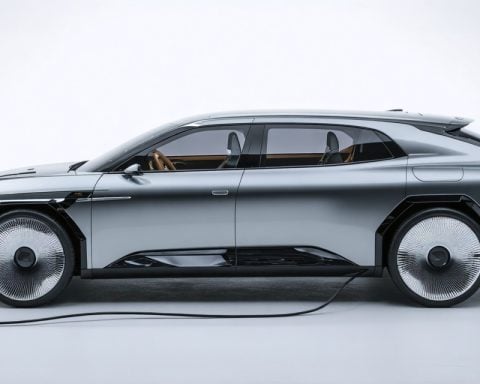- Rivian Automotive’s stock has surged by 35% over the past quarter, driven by strategic initiatives and expanding market opportunities.
- The R1S SUV emerged as the tenth best-selling domestic EV in 2024, with Rivian delivering a combined total of 51,500 units of the R1S, R1T pickup, and its electric commercial van.
- The company has expanded the availability of its Rivian Commercial Van (RCV) to fleet operators beyond Amazon, attracting diverse industry interest.
- Under CEO R.J. Scaringe, Rivian is advancing hands-free driving technology with aspirations for full autonomy by 2026.
- Rivian’s financial performance exceeded expectations, achieving a gross profit of $170 million in the last quarter.
- The anticipated R2 SUV is slated for 2026, with 2025 seen as a critical development phase for Rivian’s growth and market influence.
Rivian Automotive, the ambitious electric vehicle (EV) prodigy, stands on the cusp of a transformative journey as 2025 approaches. With its fresh burst of momentum, the firm is poised to potentially redefine its market stance. Rivian’s recent triumphs have not gone unnoticed—its stock has surged by a remarkable 35% over the past quarter, buoyed by its strategic moves and emerging opportunities.
Picture Rivian’s R1S SUV, zipping into the spotlight as the tenth best-selling domestic EV of 2024, with a delivery tally of 51,500 units encompassing its rugged R1T pickup and nimble electric commercial van. Now, visualize Rivian unlocking a new chapter as it offers this commercial van, the rechristened Rivian Commercial Van (RCV), to fleet operators beyond its initial exclusive partner, Amazon. From plumbers to florists, inquiries from diverse sectors pour in, painting a vibrant tapestry of expanding possibilities.
Rivian’s audacious push doesn’t halt at diversified fleets. Under CEO R.J. Scaringe’s vigilant eye, the company forges ahead with advanced, hands-free driving technology, a prelude to its vision for full autonomy by 2026. As Scaringe prepares for a significant dialogue with Nvidia’s automotive luminary, the company’s trajectory in AI-infused EV innovation seems resolute.
Financially, Rivian has shattered expectations, achieving a positive gross profit of $170 million in the last quarter, far outpacing Wall Street’s forecasts. The stage is thus set for the eagerly anticipated R2 SUV, slated for 2026, with 2025 serving as a critical proving ground. As Rivian navigates this promising road, the essential question looms: can it captivate the mass market? For investors eyeing potential, Rivian might just be the spark in the EV realm they’ve been waiting for.
The Rise of Rivian: What Lies Ahead for the EV Challenger
How-To Steps & Life Hacks
How to Schedule a Test Drive for a Rivian Vehicle:
1. Visit Rivian’s Official Website: Navigate to Rivian and find the “Test Drive” section usually under the ‘Experience’ tab.
2. Choose Your Model: Select which vehicle you want to test, either the R1S SUV or R1T pickup.
3. Find a Location: Enter your location to find the nearest available test drive center.
4. Schedule a Time: Pick a date and time that suits you and fill out any required information.
5. Confirmation: You will receive a confirmation email with further instructions.
Life Hack: If test drives are limited, connect with Rivian owners through online communities or forums. They often have insights or are open to answering questions.
Real-World Use Cases
Rivian’s lineup, particularly the RCV (Rivian Commercial Van), is being utilized across multiple sectors:
– Delivery Services: Companies like Amazon already demonstrated the van’s utility in efficient, eco-friendly parcel delivery.
– Tradespeople: Plumbers and electricians are attracted by the vehicle’s capacity for custom kits, making them mobile workstations.
– Floral Deliveries: Florists appreciate the ample cargo space and climate controls for delivering fresh products.
Market Forecasts & Industry Trends
Analysts predict that Rivian will continue to capitalize on its partnership with Amazon while diversifying its client base. By 2025, EVs are expected to make up 10% of global vehicle sales, and Rivian is positioning itself to capture a significant share of this growth. As of now, Rivian’s entry into the commercial sector aligns with a broader industry shift toward electrifying fleet vehicles.
Reviews & Comparisons
Rivian R1S vs. Tesla Model X:
– Price: Rivian R1S is generally positioned at a lower price point than Tesla’s Model X, making it more accessible to a broader audience.
– Performance: Both offer impressive speed and handling, but Rivian’s focus on off-road capabilities gives it an edge for adventure enthusiasts.
– Features: While Tesla boasts advanced autopilot features, Rivian’s commitment to hands-free technology by 2025 is eagerly anticipated.
– Interior: Rivian is praised for its rugged yet luxurious cabin design, appealing to those needing functionality without sacrificing style.
Controversies & Limitations
One of Rivian’s challenges remains its ability to scale production to meet market demand. Their dependence on suppliers and manufacturing facilities poses potential bottlenecks. Furthermore, the transition to autonomous driving presents regulatory hurdles and necessitates rigorous testing to ensure safety.
Features, Specs & Pricing
Rivian R1S SUV:
– Base Price: Approximately $70,000
– Range: 300+ miles on a full charge
– Power: Delivers over 750 horsepower
– Towing Capacity: Up to 7,700 pounds
– Interior Technology: A spacious interior features a 15.6-inch central display and six USB ports.
Security & Sustainability
Rivian places a strong emphasis on security by incorporating over-the-air updates to address potential vulnerabilities, similar to other leading EV makers like Tesla. On the sustainability front, Rivian’s assembly plants aim to utilize renewable energy and propose carbon-neutral operations within the next decade.
Insights & Predictions
Experts suggest that Rivian’s emphasis on the commercial sector, along with its potential strides in autonomous technology, could position it as a formidable player by 2026. Its continued partnerships and technology developments are expected to pivotally enhance its market presence.
Tutorials & Compatibility
Rivian’s Infotainment System Overview:
– Compatibility: Supports standard Bluetooth and wireless charging but currently does not offer Apple CarPlay or Android Auto, a commonly voiced request among users.
– Navigation & Updates: Features built-in navigation with live traffic updates and real-time route recalculations.
Pros & Cons Overview
Pros:
– Strong emphasis on sustainability and eco-friendly production.
– Innovative features and design.
– Competitive pricing and growing presence in both consumer and commercial markets.
Cons:
– Production scale and delivery dependability.
– Limited compatibility with popular smart devices.
– The autonomous feature still in development stages.
Actionable Recommendations
1. For Early Adopters: Keep an eye on Rivian’s official announcements for pre-order details of the R2 SUV, expected in 2026.
2. Investors: Consider observing Rivian’s quarterly financial results and any new partnerships to gauge future stock performance.
3. Fleet Managers: Evaluate the Rivian Commercial Van’s cost benefits through the total cost of ownership models compared to traditional vehicles considering maintenance and fuel savings.
Stay informed with the evolving EV landscape by checking regularly on leading platforms like Rivian.

















